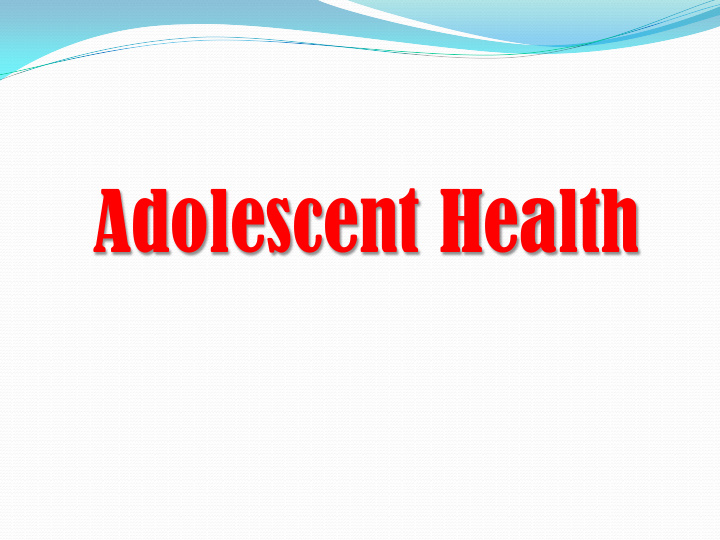



Adolescent Health
Introduction Adolescents are defined as those belonging to 10-19 years age group Worldwide 1.2 billion (19%) According to available data, 19.7% of the total population in Sri Lanka belong to this age group The adolescent population in Sri Lanka is estimated to stay around 3 million during the next few decades
National Survey on Emerging Issues among Adolescence in Sri Lanka UNICEF-2004
Life skills and other factors Stated ambitions – mostly based on traditional societal norms 67% keep on trying until they achieve their goal Out of school – 72% to find an employment 35% poor life skills 40% stressful to cope with the academic pressure No gender difference observed
Well being of adolescents 63% of school going and 70% of out of school adolescents had some attribute that they did not like themselves Half of school and 75% of out of school adolescents had some key worry.
Family, social and environmental factors affecting mental well being 60% perceived their families intimate and close One third felt their relationship with family members not good Out of school – 32% felt their families are caring and warm 13% school going adolescents felt some insecurity at home while 23% felt insecurity in their living environment
Use of alcohol, tobacco and other addictive substances School going boys – 18% (ever), 6% (current) Girls – 6% (ever), 1% (current) Prevalence increased with age 17-19 years – 32% Out of school boys – 42% (ever), 23% (current)
Global School Health survey WHO 2008
Findings Percentage of students bullied one or more times during past 30 days; 37.8% Percentage of students who felt lonely most of the times or always during last one year; 7.5% Percentage of students who felt so worried that they could not sleep at night during past 12 months; 4.9% Percentage of students who felt very sad or hopeless almost every day for 2 weeks or more during which time they stopped their activities during past 12 months; 32.5% Percentage of students who considered attempting suicide; 10.4%
Percentage of students who think suicide is a solution to a problem; 13.5% Percentage of students who have no close friends; 5.7% Percentage of students who were physically active for 60minutes per day all seven days during a normal week; 11.4% Percentage of students who spend 3 or more hours per day on sedentary activities such as computer games, watching television 34% Had breakfast most of the time or always during the past 30 day 60.1% Brushed teeth never or less than once a day during the past 30 days 27.8%
Groups Needing Special attention “ Out of school ” adolescents and street adolescents Sexually abused adolescents Commercial sex workers Adolescents with mental and physical disabilities Orphan adolescents, those in foster care and institutions Adolescents in conflict with the law Working Adolescents
Plan for Prevention of Mental Health problems and Promotion of Mental Health among school children
Strategies Ensure enforcement of policies which is essential to 1. promote mental wellbeing 2. Create appropriate environment which improve psychosocial environment Improve life skill based health education 3. 4. Empower school community to reduce risk behaviors and to promote positive behaviors for mental health promotion Community mobilization to promote psychosocial 5. environment
Activities Advocacy programme to motivate school principals to take necessary policy decisions Awareness on mental health issues and intervention to school community Training of teachers and students to improve psychosocial environment Training of teachers on life skills Organizing life skill camps for children Develop facilities to do team games Awareness programmes to reduce stress of Education
Activities contd … Screening for adolescents for illness Mobilize school community to improve to recreational and sports facilities for school children Get the students to give leadership to extracurricular activities in school & to take up community projects Establish Adolescent Friendly centers in schools & community
Activities to improve physical wellbeing Empower school community to do growth monitoring & intervention Encourage children to take morning meal Iron supplementation School Medical Inspection & correction of defects Health Promotion included in school curriculum
Recommend
More recommend